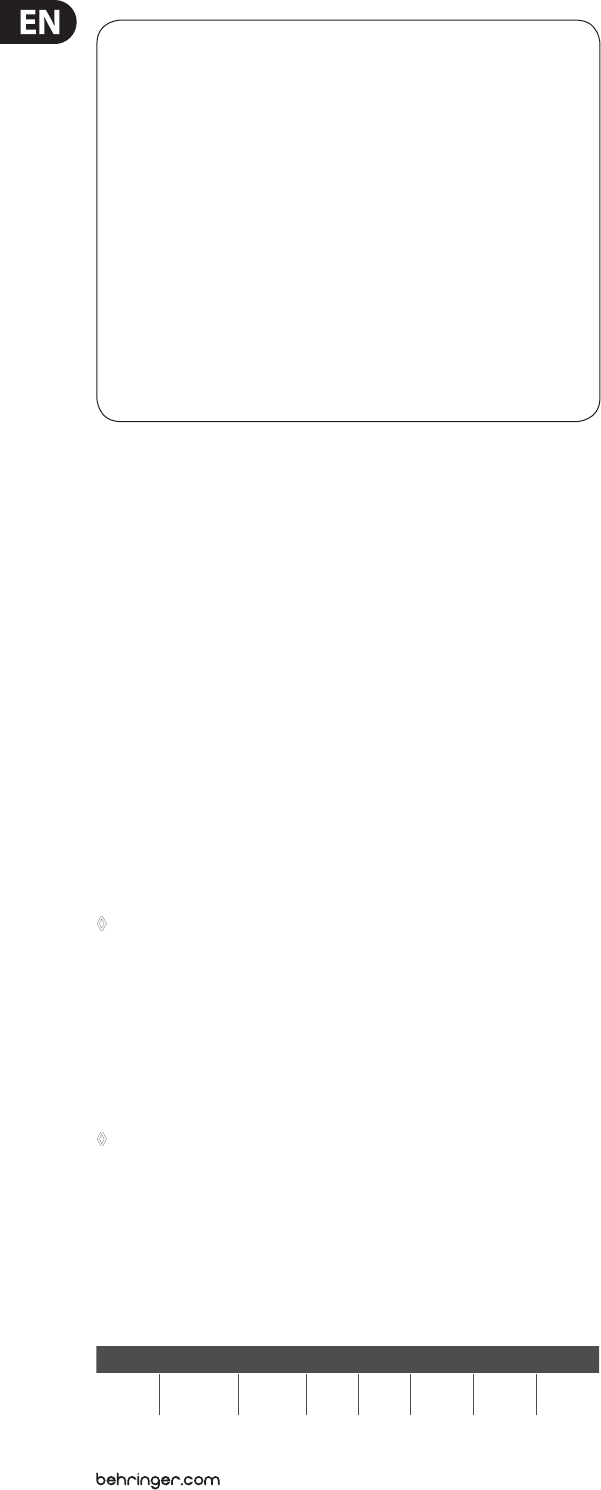
14 U-CONTROL UMA25S User Manual
Example of the Learn function:
In order to control the main volume level of a virtual instrument with
the E19 slider, follow the steps below:
Press and hold the EDIT/EXIT push button. 1.
Move the E19 slider.2.
Release the EDIT/EXIT push button.3.
Press the LEARN key.4.
Now move the volume control of the software instrument with 5.
your computer’s mouse.
When “Gd!” appears on the display, press the ENTER key.6.
To save these settings, store them in a preset.7.
5.4 Assignment of control messages in
edit mode
It is possible to specify settings that are dierent from the presets. To do so,
you need to determine which control elements on the UMA25S generate which
MIDI messages.
You need to specify how the incoming controllers are to be interpreted on the
slave unit. At this point, we suggest you refer to the user manual of the slave unit.
General assignment of control messages in Edit Mode:
Press and hold down the EDIT/EXIT push button. The device switches to 1.
Edit Mode and “Edt” appears on the display.
Use the control element you want to edit. The name of the control shows up 2.
on the display (for example, “E10”).
Release the EDIT/EXIT push button. Its LED lights up.3.
Use the rotary knobs E9 – E16 to assign the MIDI messages to the selected 4.
control element. The applicable MIDI messages and their descriptions are
found in the tables of Chapter 5.5.
In case you want to check the current parameter settings, press the ◊
push button (E1–E8) found under the rotary knob whose function you
want to examine. As soon as the push button is pressed, the settings
appear on the display for a short time. Alternatively, use the Show
Element function (see Chapter 5.6.1).
5a. Press the ENTER key to conrm. The EDIT LED goes out.
5b. Alternatively, press the EDIT/EXIT push button to cancel the changes and exit
Edit Mode. The EDIT LED goes out.
All settings made with this function are stored temporarily! If you ◊
want to store the settings permanently, save them in a preset
(see Chapter 5.1.2).
The various MIDI functions are described in detail in Chapter 5.5.
Comments on Step 4:
In Edit Mode, all settings are made by turning the knobs E9 – E16. The available
setting options depend on the data types being used.
E9 E10 E11 E12 E13 E14 E15 E16
MIDI
Data Type
MIDI
Send Channel
Parameter Value 1 Value 2
Controller
Mode
Controller
Option
Display
Value
Table 5.1: General assingment of rotary knobs in Edit Mode
MIDI Data Type:
The E9 rotary knob lets you select the message type that is to be assigned to a
control element. Refer to Chapter 5.5 for information on MIDI messages.
MIDI Send Channel:
The E10 rotary knob allows you to select the MIDI channel on which the
message is supposed to be sent. When Channel 0 is selected, the message is sent
on the GLOBAL SEND CHANNEL (see Chapter 5.7).
Parameter, Value 1, Value 2:
The rotary knobs E11 to E13 allow you to adjust the parameters and the
corresponding values of the selected MIDI message. The parameters vary
according to the MIDI message (see Chapter 5.5).
Controller Mode:
The E14 rotary knob is provided to determine the switch behavior of the
selected control element. This option is only available for switch elements
(push buttons).
The control push buttons support the controller modes “Toggle On”, “Toggle O”
and “Increment”. Toggle On is comparable to a switching function (for example,
the light switch of a room). The “On” value, which is specied with the E12
rotary knob (value 1), is sent by pressing the push button the rst time. Press the
push button a second time to send the “O” value, which is specied with the
E13 rotary knob (value 2). This setting is ideal for triggering drumloops from a
sampler (press once = Start, press a second time = Stop).
Toggle O corresponds to a push button function, which is comparable to
the switch of an electric door opener. The On value (value 1) is sent by pressing
the push button. The O value (value 2) is sent by releasing the push button.
You should use this mode when triggering short sound eects and samples
(similar to playing a keyboard).
The Increment option is only available for the messages Program Change, CC,
NRPN and After Touch. This mode allows a stepwise increment of the controller
value each time the push button is pressed. Use E15 to adjust the step interval.
Controller Option:
Select the controller mode “Increment” to determine the step interval of the
push buttons by using the E15 rotary knob. This means that each time you
press one of the push buttons, the transmitted value is increased by the step
interval you specied in advance. If the step interval is set to “10,” values 0,
10, 20, 30 ... 110, 120, 0, 10, etc. are sent one after another. You can also enter
negative values (for example, -10) to achieve a gradual decrement. In case you
have specied the lowest and highest transmittable values using the E12 and E13
rotary knobs, all other values stay within this range. With this function, you can
use your U-CONTROL to operate control push buttons that have more than two
switching states.
Display Value:
Use the E16 rotary knob to determine whether value changes are to be
displayed on screen or not. If you decide to use the display for this purpose,
you can see the current values while using the control element. The preset
number reappears shortly after letting go of the control element.


















